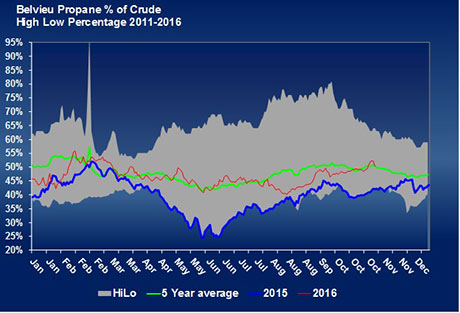Propane a more expensive Btu, despite lowering prices
Propane prices have been lowering recently and that is great thing for propane retailers and their customers. It will probably come as a surprise that propane has become a more expensive Btu over the summer, relatively speaking.
The chart above shows propane’s relative value to West Texas Intermediate (WTI) crude. The chart plots a percentage relationship between the value of WTI crude and Mont Belvieu propane. Through much of the summer and fall of 2015 (blue line), propane set new five-year low relative values to WTI crude. In June of last year, Mont Belvieu propane fell to just 25 percent of WTI crude. Keep in mind that before the shale gas revolution, propane traditionally traded around 75 percent of WTI crude.
However, throughout almost all of 2016, propane has traded above last year, near the five-year average relative value to crude. Propane’s relative value took a hit in the third quarter as propane exports dropped. In fact, values came near where they were in 2015.
Relative value started rising at the beginning of the fourth quarter with the help of crop drying and improving exports. A drop in crude prices starting in mid-October that propane lagged helped push relative value above the five-year average. However, the relative value has been falling sharply in recent days as the drop in crude prices slows. Even as crude’s downtrend slowed, propane’s prices kept falling as a lack of winter weather maintained a bearish undercurrent in propane markets.
Propane has improved in relative value, thus becoming a more expensive Btu since last year, primarily on the increase in export capacity in the United States. It is not coincidental that propane started becoming a more expensive Btu after last December when Enterprise finished a major expansion of its propane export facility. Essentially, all the new export capacity has eliminated a bottleneck for propane, allowing its value to more accurately reflect the global market for propane.
More export capacity has been added this year. Another 150,000 barrels per day of capacity has been completed, which is a little more than the rate of increase in U.S. propane production. For the longest time, U.S. propane production was way out ahead of infrastructure projects to handle it, but that is no longer the case. If the world needs U.S. propane, the export capacity is available to fulfill the demand.
Call Cost Management Solutions today for more information about how Client Services can enhance your business at (888) 441-3338 or drop us an email at info@propanecost.com.

















